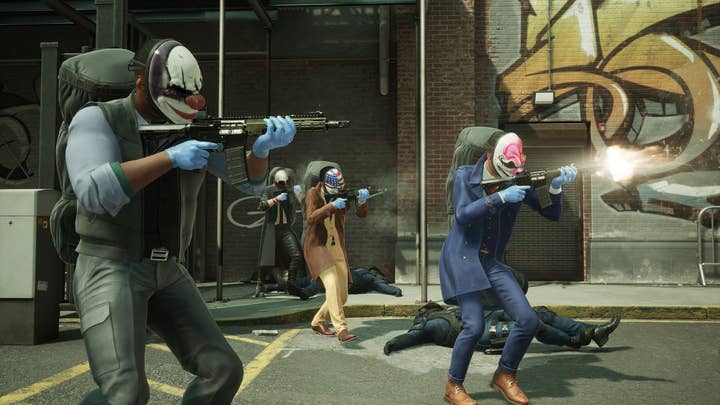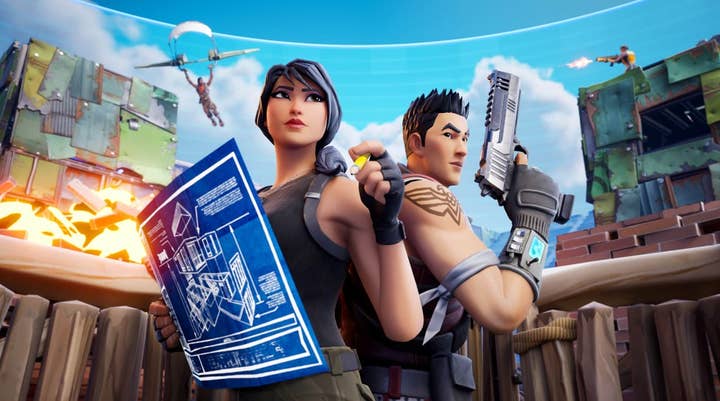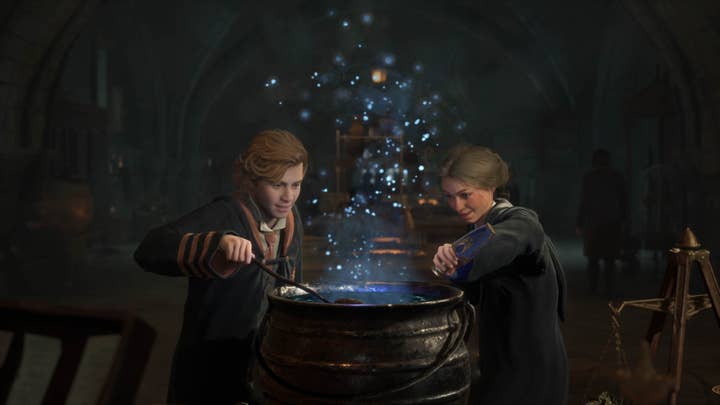The upcoming Harry Potter Live Service game will be a superb litmus test | Opinion
SJN Insights' Sam Naji explores the challenges in the games-as-a-service space, and why Warner Bros' recent comments may be telling for the rest of the industry
Sign up for the GI Daily here to get the biggest news straight to your inbox
The strong possibility that the next big Harry Potter game to come from Warner Bros will be a game as a service (GAAS) is an enticing prospect, but not for the reasons Warner Bros expects.
Sony, Warner Bros, Ubisoft, EA, and Square Enix are all doubling down on making their next games live service experiences and as video game analysts have said multiple times, they cannot all succeed. The latest Jimquisition, "Live Services Are Being Sent To Die," summed up the present state of affairs when it comes to GAAS quite nicely.
A key difference with this one is that it will be built around one of the biggest franchises on the planet with an inbuilt audience of children who are all aware of the franchise. No universe building is required. The target market is already there. Hogwarts Legacy sold over 22 million units and was one of the bestselling games of 2023. Which brings us as to why, after launching one of the most successful 'traditional' games in recent years and among the bestselling games of 2023, is Warner Bros embracing the GAAS model for future games so enthusiastically?
To answer my own question, it all comes down to recurring revenue, a constant stream of revenue from an engaged player base.
The issue is that at best the live service model can be described as 'tough.' The fact is growth in video game spending is slowing down to single figure percentage points, which means the pool to dip into new live service spending is beginning to dry up. What is left can be categorised as spending cannibalism. Simply put, a game that relies on recurring spending can only be successful upon the failure of other games that also rely on recurring spending. To increase the pool, you either need new players or increased spending from the existing player base. I would argue neither is happening.
The low retention numbers for the newly released GAAS Payday 3 are testament that the philosophy "if we build it, they will come" is no longer sufficient. Most of the Payday 3 gamers complained that the game played no different to Payday 2, a game where Payday gamers had already invested most of their money and time into. So why should they make the jump? For many jumping on a new live service game which has a low cumulative player base, from an established one which has a high cumulative player base, made no sense.
For new GAAS titles to achieve unrelinquished success, they need to offer something so new and original that gamers feel the sacrifice in lost time and investment from their older GAAS titles is worth it. This is a chicken and egg conundrum. Gamers will most likely jump onto a new live service game if it gains traction, but to get traction, it needs the gamers. As Sterling has pointed out the list of failed live service games is getting longer and longer as more and more titles fail to find a long-term audience.
If Warner Bros cannot succeed with Harry Potter as a GAAS, then quite frankly I see little future in releasing new a GAAS title because these new games will either be DOA or have a short lifespan
One of the factors that accounts for successful originality is compelling gameplay. To boil it down to its basic component, will a new GAAS title be fun to play? To their detriment publishers are beginning to forget that new games (GAAS or traditional) should be fun.
For example, the new sweetheart GAAS, Palworld, sold gangbusters, with sales exceeding 25 million units in a spate of weeks, but already retention has fallen by some 84% since launch. Why? There are probably many reasons; when I asked my ten-year-old son why he stopped playing he said it was because the game had confusing gameplay mechanics. He then went straight back to playing Fortnite, where his friends are. The initial buzz to play a game which had the aesthetics of a Pokémon world was not enough to sustain durability.
Similarly, when The Finals released on Steam, the first person shooter created a huge wave of interest and strong community feedback, but even that game lost more than four fifths of its core audience just six weeks after launch. It could be argued that competition from other established free-to-play and GAAS shooters dragged away those gamers. These two examples illustrate that initial success does not guarantee longevity if gamers get bored or are attracted to the next shiny new GAAS game.
The worrying part is that the consensus for both games is that they are fun to play, so even fun itself may not be the sticky factor for player base retention. That sparks trouble. Given news from a recent report that 95% of studios are working on or aim to release a live service game, it beggars belief. I fear these studios are all chasing a gold rush, after the gold has been mined by those who came before them.
An abundance of new GAAS titles all competing against each other in a tapped-out market is bad enough, but they also face the pressure that the established live service games seem to be getting more successful, not less. Increased revenue growth for older GAAS titles does not make for a comfortable market for new entrants, irrespective of how attractive that market looks. Similar to how only a few mobile games have dominated revenue in that sector, that same trend has already started to occur in the console and PC GAAS sector as well.

In a speaking event for Morgan Stanley, Warner Bros President of Global Streaming and Games, JB Perrette, said the traditional gaming market was “volatile” and that growth [in revenue] would come from “where people can live and work and build and play in that world in an ongoing basis”. That is all very well and good but if you look at the list of the most successful GAAS games, most of them are not that. Data has proven that the most successful DLC for GAAS are cosmetics, and the most successful GAAS gameplay lend themselves to instant gratification.
Outside Minecraft or Rust, world building has not been at all successful as a live service experience. One could argue the appeal of Minecraft is because of its versatility, its ability to be anything it wants to be for the player. It is the ultimate expression in personalisation. This is very difficult to replicate with the universe of an established IP or franchise.
A game that relies on recurring spending can only be successful upon the failure of other games that also rely on recurring spending
Fortnite, on the other hand, is a huge success because it is one of the best dopamine hit shooters on the market. To the credit of Epic Games, Fortnite has broken down all the core elements that makes an arena shooter entertaining and perfected it. The recent $1.5 billion equity state in Epic Games by Disney is testament to that fact.
Both Minecraft and Fortnite are at the top of the GAAS game because they constantly reinvent themselves, are simple to grasp, and have perfected cosmetic microtransactions. Other successful GAAS include CS:GO, War Thunder, Dota and the League of Legends which are all veterans of the live service market, making it difficult for those gamers to abandon these titles for newer ones any time soon. If they do “move on” to a new GAAS title, evidence is mounting up that players get want they want from it in a short space of time, then go back to their tried and tested favourite game that they already invested hundreds of hours in.
So, if you want to choose a volatile market, personally I cannot think of one more volatile than a new GAAS project.
The most important question for this new Harry Potter live service game is what sort of game will it be? Personally, I cannot see it being a dopamine hit arena shooter, nor can I see it being a purely sandbox experience. Narrative driven GAAS games like Destiny soon drop any pretence in telling an expanding story (because it will cost an absolute fortune in development cycles) and instead focus on becoming another arena shooter. News that Destiny 2 will sell Ghostbusters tie-in DLC pretty much flies in the face it wants to expand its own unique universe.
The issue for me is that the Potter universe should be built around a good narrative, but stay true to its origins. This is why Hogwarts Legacy was such a huge hit. Hogwarts engaged with its player base due to its successful aptness in feeling both authentic but not constrained to the Potter books. GAAS games, by contrast, are designed for rapid repeated replay for instant gratification. Long-term retention is attained by continually added content, while at the same time designed to entice the repeated spending via serviceable microtransactions.
This will probably mean extending the game’s universe or exploring tie-ins. Just look at Fortnite’s DLC. How all of that can be successfully implemented in the world that is Harry Potter will not be an easy task. Getting that formula right between fun, universe relevancy, increasing monetisation without breaking credibility and sustained player retention will be more alchemy than science. One thing is for sure making that game fun to play every time it is booted up days, weeks, and years, down the line, will require a huge investment on the part of the publisher. This is not a release once only commitment. This requires a plan, a roadmap of creativity and expenditure, and a declaration of commitment. If not done right it could end up costing more than traditional single player-based games.

Let us quickly delve into that supply side of GAAS. Although there is little in the way of hard facts of how much it costs to make and run GAAS titles, there are some basic principles we can apply to costing.
Firstly, unlike the traditional 'pay once' games, GAAS need constant additions with cosmetic, gameplay and season passes DLC to make them relevant and to sustain its audience. Many traditional games today require numerous patches after release, but after a certain time even those patches will come to an end and that will mean the game is done. Project teams can then move on to their next big thing. That is not the case for GAAS. For a GAAS title to be a runaway success everyone needs to work on it, constantly, both supplier and customer. It becomes a never-ending project to stay relevant.
Studios are all chasing a gold rush, after the gold has been mined by those who came before them
Development teams can use AI to help in creating new content but that new content will need to be good to prevent diminishing returns on investment. Although AI can dampen down costs, it will first need to prove itself that it can deliver on creativity and do away with human teams or make them work more effectively. The fact is whether AI or human, the cost of enhancing the GAAS experience could end up higher than the returns in microtransaction revenues if that new content is not compelling for the player. What happens then? What happens when players move on? Will the publisher just pull the plug and call it a day?
We have seen this sort of thing before with games such as Bablyon’s Fall and Chocobo GP, the optics of which was not great. As Sterling has pointed out, this hard stop can be a bitter pill to swallow for those gamers who invested in a failed GAAS title, both in money and time. They expected some degree of longevity. Personally, whenever I see this happen, I cannot help but think of the farewell message from the dolphins in The Hitchhikers Guide To The Galaxy: "So long and thanks for all the fish." It might at first feel humorous, but if it keeps on happening, the chances of attracting gamers to new GAAS titles in the future becomes even more precarious.
This could explain why the established GAAS are doing so well. It is because they have been around long enough to have won the hearts, minds, and wallets of its loyal audience.
Although not strictly a GAAS business, Roblox Corp. can give us an insight on the economics of running a live service model. Roblox is somewhat complicated by the fact it is more of a platform which runs numerous GAAS titles. The company makes money from microtransactions from user generated content, which it must pay royalties. This means there are similarities between the two models. Essentially both rely on microtransactions as income, and both rely on a constant flow of new content to make those microtransactions happen.
To date Roblox has not made a profit. What is compounding the problem is the fact that as top line revenue increases year on year, so have the losses. As to whether there is a direct correlation between the two it is hard to say but, as we can see in the graph, R&D costs are keeping pace with revenue. If this economic model is repeated with GAAS titles, and I suspect it is (given the headline Palworld server costs up 359%, will be $5 million a year at this rate) then running a GAAS can become a false economy if gamers begin to move away from the game and stop spending.

To conclude, maybe Warner Bros can be successful in releasing a Harry Potter GAAS that enjoys longevity with a healthy install base like Minecraft or Fortnite. So far Warner Bros attempt with the Suicide Squad: Kill The Justice League, which is built around another well-known brand, the DCU (Detective Comic Universe) eluded them of that triumph.
I would say that it is ideally all about the kids. What do they want from a GAAS? What do they want from a Harry Potter game? What do they want from a Harry Potter GAAS? Can the two be reconciled? This is why the Harry Potter GAAS is so important because it is so relevant, especially after the success of Hogwarts Legacy. For video game analysts this new game will be the perfect litmus test to see whether GAAS has a future outside the grandiose titles of Fortnite, Minecraft, Roblox, League of Legends, Call of Duty Warzone, Destiny, Apex Legends, among others. For Warner Bros. the stakes are much higher, and I wish them luck.
On a final thought, if Warner Bros cannot succeed with Harry Potter as a GAAS, then quite frankly I see little future in releasing new a GAAS title because these new games will either be DOA or have a short lifespan from the increased competition by the older GAAS titles that will fight back to hold on to their market share. Shame, as a lot of video game studios are now pinning their hopes on this model.
Sam Naji is founder of video game analytics and consultancy firm SJN Insight
Sign up for the GI Daily here to get the biggest news straight to your inbox

